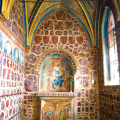From the village, you will quickly (but breathlessly!) reach the promontory occupied by the castle. After the drawbridge, you will have to wait, unless you have already booked, because all the visits are guided. The tour follows the four main parts that make up the castle and do not have the same duration nor the same theme, so compose it according to your interests or your time.
First, there is the suburb with the main entrance where many artists and craftsmen present their skills. There is of course a bit of a tourist side to it, and you won't find the bargains of the century here, but you will get a good overview of Czech craftsmanship. Next is the archbishop's palace, the courtyard with the cashier's office, from which a staircase leads down to an 80 m deep well that supplied the castle with water until 1923.
On the first floor of the royal palace there is a courtiers' hall, which shows the history of the castle, and other rooms with objects and works of Czech history. The well-documented exhibition will allow you to follow the main stages of the construction and renovation of the building. In particular, the overviews show that Charles IV really designed the castle as a vault to house the jewels, the royal crown and the most precious holy relics.
The last part of the castle is the wing of which the church of St. Mary is a part, decorated with murals, probably the work of Nicolas Wurmser, a Strasbourgeois, dating from approximately the middle of the 14th century. The church is linked by a narrow passage to the chapel of Saint Catherine, tiny and private; only Charles IV had the right to use it. He came here to meditate, and none of his wives were allowed to disturb him here. Its walls are decorated with precious stones. The big tower, which dominates the whole castle and whose walls are 6 m thick, is occupied by the luxurious chapel of the Holy Cross. It was here that the king decided to install the crown jewels and relics. In the past, the chapel housed 128 paintings on wood, by Master Theodorik, made between 1357 and 1365. This chapel had to be closed to the public because the walls set with precious stones were badly damaged. The jewels are now in St. Vitus Cathedral in Prague and the paintings are part of the National Gallery.
Did you know? This review was written by our professional authors.
Members' reviews on CASTLE OF KARLŠTEJN (HRAD)
The ratings and reviews below reflect the subjective opinions of members and not the opinion of The Little Witty.














城内は自由見学はできず、随時出発するガイドツアー(通常3コースが用意されているが、当日は閑散期のせいか1コースのみの設定だった)に参加しなくてはなりませんでした。
私はサイクリングの途中に立ち寄っただけなので、次回はゆっくり訪れたいと思います。
駐車場から城までの約1kmは歩行者専用道路で、のんびり歩くことができます。